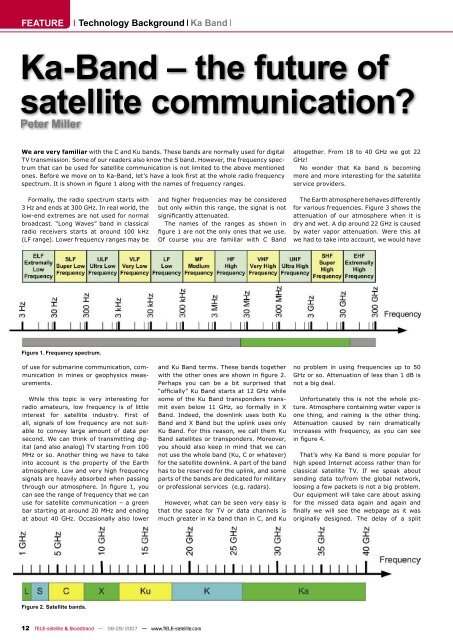Small&Solid - TELE-satellite International Magazine
Small&Solid - TELE-satellite International Magazine
Small&Solid - TELE-satellite International Magazine
You also want an ePaper? Increase the reach of your titles
YUMPU automatically turns print PDFs into web optimized ePapers that Google loves.
FEATURE<br />
Technology Background Ka Band<br />
Ka-Band – the future of<br />
<strong>satellite</strong> communication?<br />
Peter Miller<br />
We are very familiar with the C and Ku bands. These bands are normally used for digital<br />
TV transmission. Some of our readers also know the S band. However, the frequency spectrum<br />
that can be used for <strong>satellite</strong> communication is not limited to the above mentioned<br />
ones. Before we move on to Ka-Band, let’s have a look first at the whole radio frequency<br />
spectrum. It is shown in figure 1 along with the names of frequency ranges.<br />
Formally, the radio spectrum starts with<br />
3 Hz and ends at 300 GHz. In real world, the<br />
low-end extremes are not used for normal<br />
broadcast. “Long Waves” band in classical<br />
radio receivers starts at around 100 kHz<br />
(LF range). Lower frequency ranges may be<br />
Figure 1. Frequency spectrum.<br />
of use for submarine communication, communication<br />
in mines or geophysics measurements.<br />
While this topic is very interesting for<br />
radio amateurs, low frequency is of little<br />
interest for <strong>satellite</strong> industry. First of<br />
all, signals of low frequency are not suitable<br />
to convey large amount of data per<br />
second. We can think of transmitting digital<br />
(and also analog) TV starting from 100<br />
MHz or so. Another thing we have to take<br />
into account is the property of the Earth<br />
atmosphere. Low and very high frequency<br />
signals are heavily absorbed when passing<br />
through our atmosphere. In figure 1, you<br />
can see the range of frequency that we can<br />
use for <strong>satellite</strong> communication – a green<br />
bar starting at around 20 MHz and ending<br />
at about 40 GHz. Occasionally also lower<br />
Figure 2. Satellite bands.<br />
12 <strong>TELE</strong>-<strong>satellite</strong> & Broadband — 08-09/2007 — www.<strong>TELE</strong>-<strong>satellite</strong>.com<br />
and higher frequencies may be considered<br />
but only within this range, the signal is not<br />
significantly attenuated.<br />
The names of the ranges as shown in<br />
figure 1 are not the only ones that we use.<br />
Of course you are familiar with C Band<br />
and Ku Band terms. These bands together<br />
with the other ones are shown in figure 2.<br />
Perhaps you can be a bit surprised that<br />
“officially” Ku Band starts at 12 GHz while<br />
some of the Ku Band transponders transmit<br />
even below 11 GHz, so formally in X<br />
Band. Indeed, the downlink uses both Ku<br />
Band and X Band but the uplink uses only<br />
Ku Band. For this reason, we call them Ku<br />
Band <strong>satellite</strong>s or transponders. Moreover,<br />
you should also keep in mind that we can<br />
not use the whole band (Ku, C or whatever)<br />
for the <strong>satellite</strong> downlink. A part of the band<br />
has to be reserved for the uplink, and some<br />
parts of the bands are dedicated for military<br />
or professional services (e.g. radars).<br />
However, what can be seen very easy is<br />
that the space for TV or data channels is<br />
much greater in Ka band than in C, and Ku<br />
altogether. From 18 to 40 GHz we got 22<br />
GHz!<br />
No wonder that Ka band is becoming<br />
more and more interesting for the <strong>satellite</strong><br />
service providers.<br />
The Earth atmosphere behaves differently<br />
for various frequencies. Figure 3 shows the<br />
attenuation of our atmosphere when it is<br />
dry and wet. A dip around 22 GHz is caused<br />
by water vapor attenuation. Were this all<br />
we had to take into account, we would have<br />
no problem in using frequencies up to 50<br />
GHz or so. Attenuation of less than 1 dB is<br />
not a big deal.<br />
Unfortunately this is not the whole picture.<br />
Atmosphere containing water vapor is<br />
one thing, and raining is the other thing.<br />
Attenuation caused by rain dramatically<br />
increases with frequency, as you can see<br />
in figure 4.<br />
That’s why Ka Band is more popular for<br />
high speed Internet access rather than for<br />
classical <strong>satellite</strong> TV. If we speak about<br />
sending data to/from the global network,<br />
loosing a few packets is not a big problem.<br />
Our equipment will take care about asking<br />
for the missed data again and again and<br />
finally we will see the webpage as it was<br />
originally designed. The delay of a split

















